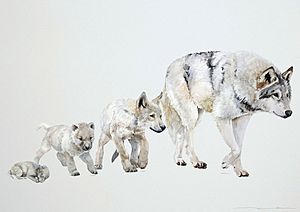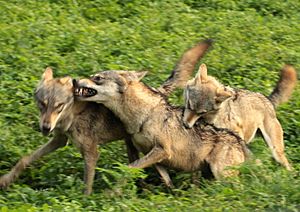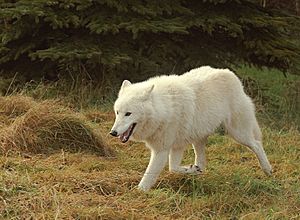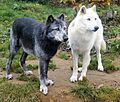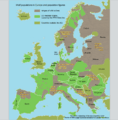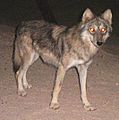Wolf facts for kids
Quick facts for kids Grey wolfTemporal range:
Mid Pleistocene – Recent |
|
|---|---|
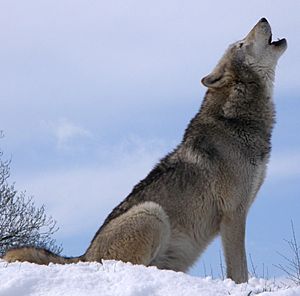 |
|
| A wolf howling |
|
| Conservation status | |
| Scientific classification | |
| Kingdom: | |
| Class: | |
| Order: | |
| Family: | |
| Genus: | |
| Binomial name | |
| Canis lupus Linnaeus, 1758
|
|
The wolf (Canis lupus) is a wild mammal that belongs to the carnivore group. People sometimes call it the timber wolf or grey wolf.
Wolves are the ancestors of the domestic dog. Scientists found that dogs came from wolves. These wolves were tamed less than 16,300 years ago. This happened south of the Yangtze River in China.
There are many different types of wolves, called subspecies. An example is the Arctic wolf. Some wolf subspecies are on the endangered species list. But overall, the grey wolf (Canis lupus) is not considered in danger. The IUCN says it is of 'least concern'.
Contents
What Wolves Look Like
Adult wolves are usually 1.4 to 1.8 meters (4.6 to 5.9 feet) long. This length is measured from their nose to their tail. Their size depends on the specific type of wolf. Wolves in the far north are often larger than those in the south.
Adult wolves typically weigh between 23 to 50 kilograms (50 to 110 pounds). The heaviest wolf ever recorded weighed 86 kilograms (190 pounds).
A wolf has a long snout and short ears. It also has long legs and a long, bushy tail. Wolves usually stand 26 to 38 inches (66 to 97 cm) tall at the shoulder.
Their fur has two layers. The top layer keeps dirt away. The under-layer is good at keeping water out. Wolf fur can be grey, white, taupe, brown, or black. It can also be a mix of these colors.
Wolf Life and Behavior
Wolves live in groups called "packs". They are pack hunters, meaning they hunt together. A pack is usually made up of family members. This often includes the parent wolves and their young. Wolves without a pack might join another group.
Packs usually have up to 12 wolves. Some packs can be as small as two or as large as 25. The leaders are the parent male and parent female. They are the ones who breed. Wolves mark their territory with scent and by howling. They will fight other wolves who enter their area.
Young wolves are called 'pups' or 'whelps'. Female wolves usually give birth to five or six pups at a time.
Wolves make a sound called a howl. They howl to talk to each other from far away. They also howl to mark the edges of their territory. Wolves also use complex body language to communicate.
Wolves can run very fast and for long distances. A wolf can run 20 to 30 miles (32 to 48 kilometers) in one day.
Grey wolves usually live for six to eight years in the wild. In zoos, they can live for up to 17 years.
What Wolves Eat (Diet)
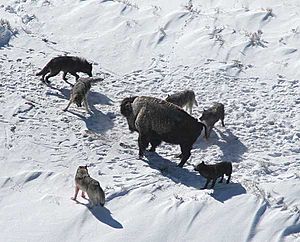
Wolves are carnivores, which means they eat meat. They mostly eat medium to large hoofed animals. These animals are called ungulates. But wolves will also eat rodents, insectivores, and foxes.
Some wolves have been seen eating salmon, seals, and even beached whales. They also eat lizards, snakes, and birds. Large animals like moose, bison, and deer are also part of their diet.
A wolf can eat about 9 kilograms (20 pounds) of meat in one meal. That's like eating 100 hot dogs!
Wolves usually stalk old or sick animals. It is easier for them to catch these animals. They are slower and weaker. Wolves do not always catch what they hunt. They might go days without food. Sometimes, only one out of twelve hunts is successful.
The parent male and female wolves eat first. Then the other pack members eat. If the prey is large, wolves might hide some food. They come back later to eat it. Wolves have very sharp teeth. These teeth help them tear large pieces of meat. They can eat up to 2/7 of their own body weight. Wolves also swallow food and then bring it back up for their pups to eat.
Where Wolves Live (Habitat)
Wolves live in Europe, Asia, and North America. They can live in many different places. These include forests, deserts, mountains, tundra, and grasslands. Sometimes, they even live near towns and cities.
Wolf Social Structure
The wolf is a social animal. Wolf groups are called packs. There are also lone wolves. Most lone wolves leave their birth pack to start their own or join another.
A wolf pack's main social unit is the nuclear family. This means a mated pair (the parents) and their young. In North America, packs usually have eight wolves. In Europe, they average 5.5 wolves. In Asia, a pack often has eight wolves. This includes two adults, young wolves, and yearlings. Some very large packs have had up to 42 wolves!
Young wolves usually stay with their pack for 10 to 54 months. Then they leave. Some stay close to their parents. Others travel very far. They can go over 206 km (128 mi), 390 km (240 mi), or even 670 km (420 mi) from where they were born.
Wolf packs rarely let other wolves join them. They usually kill wolves from other packs. If a wolf is adopted, it's almost always a young one (1 to 3 years old). This young wolf is not likely to compete with the parent wolves for breeding. This usually happens between February and May. Adopted male wolves might mate with a female in the pack. Then they might form their own pack. Sometimes, a lone wolf is adopted to replace a parent wolf who has died.
Wolves are territorial animals. They usually claim areas much larger than they need. This helps them have enough prey. The size of their territory depends on how much food is available. It also depends on the age of the pack's pups.
Wolf packs are always moving to find food. They cover about 9% of their territory each day. Wolf packs usually stay in their territory. They only leave if there is a severe lack of food.
How Wolves Communicate
Wolves communicate using sounds, body positions, scent, touch, and taste.
The moon's phases do not affect wolf howling. Despite what many people think, wolves do not howl at the moon. Wolves howl to gather the pack. This happens before and after hunts. They also howl to warn others, especially near their den. They howl to find each other during storms. They also howl when crossing new areas. Howling helps them talk over long distances. Wolf howls can be heard over areas up to 130 square kilometers (50 sq mi).
Other wolf sounds include growls, barks, and whines. Wolves do not bark as loudly or as much as dogs do when fighting. They bark a few times and then move away from danger.
Scent marking is a good way to show territory. It is often used with scratch marks. Wolves mark their territory more often when they find marks from other packs. Lone wolves rarely mark. But new wolf pairs mark the most. These marks are usually left every 240 meters (260 yards). They are placed along common travel paths and at crossings. These marks can last for two to three weeks. They are often near rocks, trees, or large animal skeletons.
Wolf Reproduction and Life Cycle
Wolves are monogamous. This means mated pairs usually stay together for life. If one wolf dies, the other finds a new mate quickly.
Wolves become old enough to breed at two years of age. When wolves first breed depends on their environment. If there is a lot of food, or if wolf numbers are managed, they can have pups younger. This helps them use the plentiful resources. Female wolves can have pups every year. One litter per year is typical.
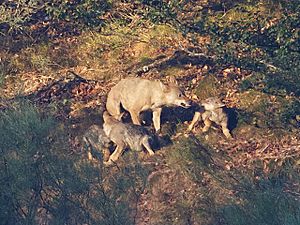
Dens are usually built for pups during the summer. Female wolves use natural shelters for dens. These include cracks in rocks, cliffs over riverbanks, and holes covered by plants. Sometimes, they use burrows dug by smaller animals. These include foxes, badgers, or marmots. A used burrow is often made wider and partly rebuilt. Rarely, female wolves dig their own burrows. These are usually small and short, with one to three openings.
The den is usually less than 500 meters (550 yards) from water. It often faces south. This way, it gets more sun and snow melts faster. Resting spots, play areas for pups, and food remains are often found near wolf dens.
The pregnancy lasts 62 to 75 days. Pups are usually born in spring. In very cold places like the tundra, they are born in early summer. Young females have four to five pups. Older females have six to eight pups, and sometimes up to 14.
Newborn wolf pups look like young German Shepherd Dogs. They are born blind and deaf. They have short, soft, grayish-brown fur. They weigh 300 to 500 grams (10.6 to 17.6 ounces) at birth. They start to see after nine to 12 days. Their baby teeth appear after one month. Pups leave the den for the first time after three weeks. At one and a half months old, they can run away from danger. Mother wolves stay in the den for the first few weeks. The fathers bring food for them and their young. Pups start eating solid food at three to four weeks old. They grow very fast in their first four months. During this time, a pup's weight can increase almost 30 times. Wolf pups start play-fighting at three weeks old. Their bites are gentle and controlled. Real fights to decide who is in charge happen at five to eight weeks old. By autumn, the pups are old enough to hunt large prey with the adults.
Arctic Wolf
The Arctic wolf might be a subspecies of the grey wolf. They live in the Canadian Arctic Circle, Greenland, and Iceland.
The Arctic wolf's home is very harsh. Not much is known about their daily lives. They are more friendly than other wolves. But they can still be very aggressive.
Their winter fur is very good at keeping them warm. Wolves in cold places can rest comfortably outside at -40°C (-40°F). They do this by putting their nose between their back legs. They cover their face with their tail. Wolf fur keeps them warmer than dog fur. It also does not collect ice from their warm breath. Since about 1930, the skulls of many Arctic wolves have become smaller. This might be because they have bred with dogs. Adult Arctic wolves are about 3 feet (91 cm) tall. They weigh about 75 to 120 pounds (34 to 54 kg). Arctic wolves live in groups of 7 to 20 wolves. They may live 5 to 10 years in the wild. They can live for 14 years if cared for in a zoo.
Wolves and Humans
Many people think wolves are mean creatures. But they are actually much gentler than imagined. Wolves usually become violent if they are sick. They also act aggressively to protect other wolves in their pack. Many people, especially in Canada and Alaska, have huskies as pets. Huskies are close relatives of the wolf.
A few years ago, wolves were brought back to Yellowstone National Park in Wyoming. This was done to help them breed, as they were becoming endangered. The wolves have done very well in the park. There had been no wolves there for a long time. This was because of hunting and poisoned water. Many people were not happy about the wolves returning. They were afraid the wolves would eat their sheep and cows near the park. However, wolves only eat livestock if they cannot find wild prey.
Hunting Wolves
Theodore Roosevelt said wolves are hard to hunt. This is because they are hard to find. They have sharp senses and can run for a long time. They can also quickly hurt and kill a dog.
One way to hunt wolves in Russia is to trap a pack in a small area. Hunters surround the area with poles that have a human scent. This method works because wolves are afraid of human smells. But it can stop working if wolves get used to the smell. Some hunters can attract wolves by copying their calls. In Kazakhstan and Mongolia, people traditionally hunt wolves with eagles and falcons. But this practice is becoming less common. This is because there are fewer experienced falconers. Shooting wolves from aircraft is very effective. This is because of better visibility and clear shots. Some types of dogs, like the Borzoi and Kyrgyz Tajgan, were bred specifically for wolf hunting.
Wolves Gone from Britain
All wolves in Britain were killed after hundreds of years of hunting. The last wolves lived in the Scottish Highlands. There is a story that the last one was killed there in 1743. A person named MacQueen supposedly killed it.
In the last ten years, studies have supported bringing wolves back to the English countryside and Scottish Highlands. One study was in 2007. Researchers from Norway, Britain, and Imperial College London thought wolves would help. They believed wolves would bring back plants and birds. These are now eaten by too many deer. The wolves would help keep the deer population lower. People were mostly positive about this idea. But farmers in rural areas wanted to be paid for any livestock killed by wolves.
Wolves as Pets
Wolves and wolf-dog hybrids are sometimes kept as exotic pets. Even though they are related to domestic dogs, wolves are not as easy to live with. They are generally less likely to obey human commands. They are also more likely to act aggressively. A person is more likely to be badly hurt by a pet wolf or wolf-dog hybrid than by a dog.
Wolves in Stories and Culture
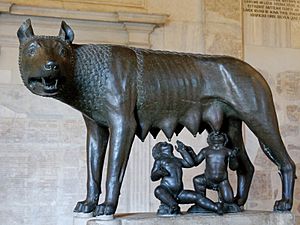
The wolf is a common symbol in myths and stories. The Ancient Greeks linked wolves with Apollo. He was the god of light and order. The Ancient Romans connected the wolf with Mars. He was their god of war and farming. They believed their city's founders, Romulus and Remus, were fed by a she-wolf. Norse mythology includes the feared giant wolf Fenrir. It also has Geri and Freki, who were Odin's loyal pets.
In Chinese astronomy, the wolf stands for Sirius. It guards the heavenly gate. In China, the wolf was traditionally linked to greed and cruelty. In both Hinduism and Buddhism, gods of protection ride wolves. In Vedic Hinduism, the wolf is a symbol of the night. The daytime quail must escape its jaws. In Tantric Buddhism, wolves are shown living in graveyards and destroying dead bodies.
In the Pawnee creation story, the wolf was the first animal on Earth. When humans killed it, they were punished. They faced death, destruction, and lost their ability to live forever. For the Pawnee, Sirius is the "wolf star." Its coming and going meant the wolf was moving between the spirit world and Earth. Both Pawnee and Blackfoot people call the Milky Way the "wolf trail." The wolf is also an important symbol for clans of the Pacific Northwest, like the Kwakwakaʼwakw.
The idea of people turning into wolves, and vice versa, is found in many cultures. One Greek myth tells of Lycaon. He was turned into a wolf by Zeus as punishment for his bad actions. The legend of the werewolf has been popular in European folklore. It involves people willingly turning into wolves to attack and kill others. The Navajo traditionally believed that witches could turn into wolves. They would wear wolf skins and kill people and raid graveyards. The Dena'ina believed wolves were once men. They saw them as brothers.
Wolves in Fables and Books
- Aesop included wolves in several of his fables. His most famous is "The Boy Who Cried Wolf". This story is about people who often give false alarms. The saying "to cry wolf" comes from this fable.
- The Bible uses an image of a wolf lying with a lamb. This is in a hopeful vision of the future.
- The story of "Little Red Riding Hood" was first written in 1697 by Charles Perrault. This tale helped give the wolf a bad image in Western countries. The Big Bad Wolf is shown as a villain. He can copy human speech and wear human clothes.
- Bad wolf characters also appear in The Three Little Pigs and "The Wolf and the Seven Young Goats".
- Wolves are main characters in Rudyard Kipling's The Jungle Book. Wolf scientists have praised his description of wolves in the book.
Images for kids
-
Wolf–dog hybrids in the wild animal park at Kadzidłowo, Poland. Left: product of a male wolf and a female spaniel; right: from a female wolf and a male West Siberian Laika.
-
An Italian wolf in a mountainous habitat in the Apennines in Sassoferrato, Italy
-
Iberian wolf pups stimulating their mother to regurgitate some food
-
The Capitoline Wolf, sculpture of the mythical she-wolf feeding the twins Romulus and Remus, from the legend of the founding of Rome, Italy, 13th century AD. (The twins are a 15th-century addition.)
-
Tlingit helmet and collar representing a wolf
-
Akela, the Lone Wolf, leader of the Seeonee Wolf Pack which raises Mowgli in The Jungle Book. From an 1895 illustration by John Lockwood Kipling.
-
Flag of the Pawnee Nation
See also
 In Spanish: Lobo para niños
In Spanish: Lobo para niños



